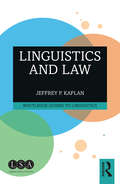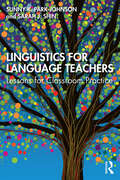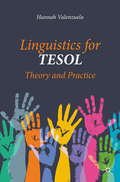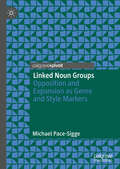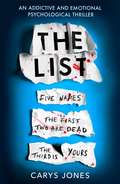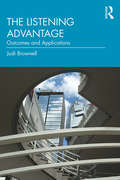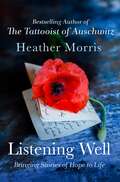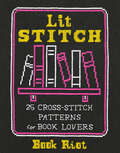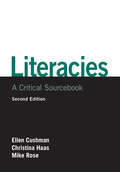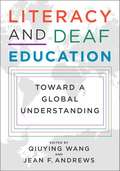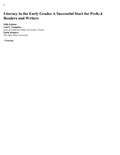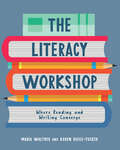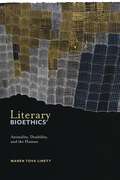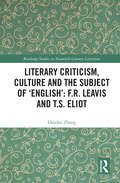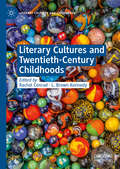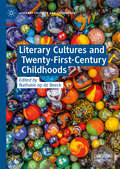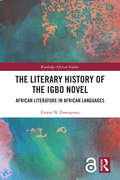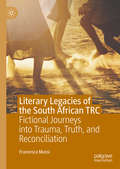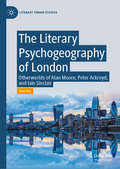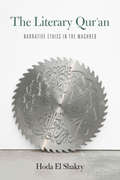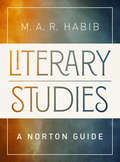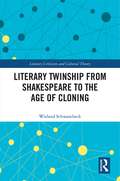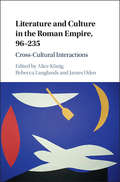- Table View
- List View
Linguistics and Law (Routledge Guides to Linguistics)
by Jeffrey P. KaplanLinguistics and Law offers a clear and concise introduction to making sense of the law through linguistics. Drawing on lexical semantics, syntax, and pragmatics to interpret both written and spoken laws, this book: addresses how to interpret legal documents such as contracts, statutes, constitutional provisions and trademarks; provides thorough analyses of "language crimes" including solicitation, perjury, defamation, and conspiracy, as well as talk between police and criminal suspects; analyzes the Miranda warning in depth; tackles the question of whether there is a "language" of the law; draws on real-life case studies to aid understanding. Written in an approachable, conversational style and aimed at undergraduate students with little or no prior knowledge of linguistics or law, this book is essential reading for those approaching this topic for the first time.
Linguistics for Language Teachers: Lessons for Classroom Practice
by Sarah J. Shin Sunny Park-JohnsonThis book is an accessible introduction to linguistics specifically tailored for teachers of second language/bilingual education. It guides teachers stepwise through the components of language, focusing on the areas of linguistics that are most pertinent for teaching. Throughout the book there are opportunities to analyze linguistic data and discuss language-related issues in various educational and social contexts. Readers will be able to identify patterns in actual language use to inform their teaching and help learners advance to the next level. A highly readable account of how language works, this book is an ideal text for teacher education courses.
Linguistics for Language Teachers: Lessons for Classroom Practice
by Sunny Park-Johnson Sarah J. ShinThis book is an accessible introduction to linguistics specifically tailored for teachers of second language/bilingual education. It guides teachers stepwise through the components of language, focusing on the areas of linguistics that are most pertinent for teaching. Throughout the book there are opportunities to analyze linguistic data and discuss language-related issues in various educational and social contexts. Readers will be able to identify patterns in actual language use to inform their teaching and help learners advance to the next level. A highly readable account of how language works, this book is an ideal text for teacher education courses.
Linguistics for TESOL: Theory and Practice
by Hannah ValenzuelaThis textbook proposes a theoretical approach to linguistics in relation to teaching English. Combining research with practical classroom strategies and activities, it aims to satisfy the needs of new and experienced TESOL practitioners, helping them to understand the features of the English language and how those features impact on students in the classroom. The author provides a toolkit of strategies and practical teaching ideas to inspire and support practitioners in the classroom, encouraging reflection through regular stop-and-think tasks, so that practitioners have the opportunity to deepen their understanding and relate it to their own experience and practice. This book will appeal to students and practitioners in the fields of applied linguistics, TESOL, EAL, English language and linguistics, EAP, and business English.
Linked Noun Groups: Opposition and Expansion as Genre and Style Markers
by Michael Pace-SiggeThis book provides a corpus-led analysis of multi-word units (MWUs) in English, specifically fixed pairs of nouns which are linked by a conjunction, such as 'mum and dad', 'bride and groom' and 'law and order'. Crucially, the occurrence pattern of such pairs is dependent on genre, and this book aims to document the structural distribution of some key Linked Noun Groups (LNGs). The author looks at the usage patterns found in a range of poetry and fiction dating from the 17th to 20th century, and also highlights the important role such binomials play in academic English, while acknowledging that they are far less common in casual spoken English. His findings will be highly relevant to students and scholars working in language teaching, stylistics, and language technology (including AI).
The List: ‘A terrifyingly twisted and devious story' that will take your breath away
by Carys JonesFive names on a list. The first two are dead.The third is yours.A rip-roaring, addictive, intense and emotional thriller for fans of Lucy Foley, Ruth Ware, Phoebe Morgan, CL Taylor and Lisa Jewell...* * * * * * *Beth Belmont runs every day, hard and fast on the trail near home. She knows every turn, every bump in the road. So when she spots something out of place - a slip of white paper at the base of a tree - she's drawn to it.On the paper are five names. The third is her own.Beth can't shake off the unease the list brings. Why is she on it? And what ties her to the other four strangers?Then she discovers that the first two are dead.Is she next?Delving into the past of the two dead strangers, the truth Beth finds will lead her headlong into her darkest, deadliest and most dangerous nightmares...PRAISE FOR THE LIST:'Compelling, unsettling and utterly addictive, The List got deep under my skin as I read it in a single sitting' M W CRAVEN, author of The Puppet Show'A sharp psychological thriller. A captivating premise and an engrossing read with twists and turns that will keep you hooked to the very last page' ADAM HAMDY, author of Black 13'A terrifying story of guilt and remorse. A chilling reminder that the past doesn't always stay there no matter what stories we tell ourselves or others! The truth sits in the shadows and will always come to light' ALEX HART, author of Take Me Home
The List: ‘A terrifyingly twisted and devious story' that will take your breath away
by Carys JonesFive names on a list. The first two are dead.The third is yours.A rip-roaring, addictive, intense and emotional thriller for fans of Lucy Foley, Ruth Ware, Phoebe Morgan, CL Taylor and Lisa Jewell...* * * * * * *Beth Belmont runs every day, hard and fast on the trail near home. She knows every turn, every bump in the road. So when she spots something out of place - a slip of white paper at the base of a tree - she's drawn to it.On the paper are five names. The third is her own.Beth can't shake off the unease the list brings. Why is she on it? And what ties her to the other four strangers?Then she discovers that the first two are dead.Is she next?Delving into the past of the two dead strangers, the truth Beth finds will lead her headlong into her darkest, deadliest and most dangerous nightmares...PRAISE FOR THE LIST:'Compelling, unsettling and utterly addictive, The List got deep under my skin as I read it in a single sitting' M W CRAVEN, author of The Puppet Show'A sharp psychological thriller. A captivating premise and an engrossing read with twists and turns that will keep you hooked to the very last page' ADAM HAMDY, author of Black 13'A terrifying story of guilt and remorse. A chilling reminder that the past doesn't always stay there no matter what stories we tell ourselves or others! The truth sits in the shadows and will always come to light' ALEX HART, author of Take Me Home
The Listening Advantage: Outcomes and Applications
by Judi BrownellThis outcome-based text offers principles and skill-building experiences for the critical competence of listening. It serves as an adaptable supplement for courses in communication and professional studies. It draws from the author’s HURIER model, which identifies six interrelated components of listening—hearing, understanding, remembering, interpreting, evaluating, and responding—and considers the skills required to achieve the specific outcomes related to each. Varied classroom activities, including discussion questions, group processes, and other instructional strategies, facilitate skill-building and the achievement of each Listening Outcome. The final section of the text identifies those outcomes that are particularly relevant to specific career applications and provides cases to facilitate discussion and illustrate listening challenges in each field. The outcome-based, modular format allows instructors maximum flexibility in adapting instructional materials to meet the needs of specific courses and time frames. The Listening Advantage is an invaluable supplement for courses in communication studies and professional fields including education, healthcare, helping professions, law, management, and service.
Listening Well: Bringing Stories of Hope to Life
by Heather MorrisFrom New York Times bestselling author Heather Morris comes the memoir of a life of listening to others.In Listening Well, Heather will explore her extraordinary talents as a listener—a skill she employed when she first met Lale Sokolov, the tattooist at Auschwitz-Birkenau and the inspiration for her bestselling novel. It was this ability that led Lale to entrust Heather with his story, which she told in her novel The Tattooist of Auschwitz and the bestselling follow up, Cilka's Journey.Now Heather shares the story behind her inspirational writing journey and the defining experiences of her life, including her profound friendship with Lale, and explores how she learned to really listen to the stories people told her—skills she believes we can all learn."Stories are what connect us and remind us that hope is always possible."—Heather Morris
Lit Stitch: 25 Cross-Stitch Patterns for Book Lovers
by Book Riot“Savvily combines literary themes and cross-stitch designs in [a] visually appealing collection of projects . . . delightful.” —Publishers Weekly Inside Book Riot’s Lit Stitch, you’ll find a number of badass, bookish cross-stitch patterns to let you show off your love of all things literary. Some are for bookmarks, others are for wall decor, and still others can take on a whole host of finished outcomes. What they have in common is their literary bent—the patterns speak to all manner of literary-minded book lovers, who are happy to display their nerdier sides. And what better way than through your own cross-stitch art to hang on your wall, prop on your desk, or even gift to friends and family? Most if not all are beginner-friendly and can be completed in a few hours—instant stitchification! So grab yourself some excellent embroidery floss, hoops, and needles, and pick out one or more of these great cross-stitch patterns for your next project.
Literacies: A Critical Sourcebook
by Ellen Cushman Christina Haas Mike RoseThis new collection of both landmark and current essays provides a comprehensive overview of the major themes and questions that shape literacy studies today. Literacy: A Critical Sourcebook is an indispensable reference tool for anyone interested in the field of liter
Literacy and Deaf Education: Toward a Global Understanding
by Qiuying Wang Jean AndrewsInternational perspectives about literacy and deaf students is an uncharted intellectual landscape. Much of the literacy research in deaf education is conducted in English-speaking countries—primarily the United States—but 90% of deaf children live outside the U.S. and learn various signed and spoken languages, as well as diverse writing systems. Many of these children face significant educational challenges. In order to improve the literacy outcomes of deaf students around the world, it is imperative to study how children are using their local signed and spoken languages along with Deaf culture to learn to read and write. This volume fills a void in the field by providing a global view of recent theoretical and applied research on literacy education for deaf learners. Literacy and Deaf Education: Toward a Global Understanding is organized by region and country, with the first part discussing writing systems that use alphabetic scripts, and the second part focusing on countries that use non-alphabetic scripts. Some examples of the wide spectrum of topics covered include communication methodologies, curriculum, bilingual education, reading interventions, script diversity, and sociocultural development, including Deaf cultural developments. The contributors provide the results from literacy projects in fifteen countries and regions. This volume aims to widen the knowledge base, familiarize others in the field with these initiatives, and improve global understandings and outcomes of literacy teaching and learning in deaf education from birth to high school. Signed chapter summaries are available on the Gallaudet University Press YouTube channel.
Literacy in the Early Grades: A Successful Start For PreK-4 Readers and Writers
by Gail Tompkins Emily RodgersA practical and balanced approach to helping young students become fluent readers and writers Literacy in the Early Grades: A Successful Start for PreK-4 Readers and Writers presents a balanced approach to literacy instruction that will help all young students make a successful start in reading and writing. <p><p>Effective teachers know their students’ individual needs, and use their understanding of literacy development to guide their teaching. The 5th Edition provides the background knowledge, modeling, and practical resources – including authentic classroom vignettes, student work samples, minilessons, assessment tools, and a Compendium of Instructional Procedures – that will ensure you are well prepared to meet grade-level standards and lead young students to become fluent readers and writers.
Literacy Workshop: Where Reading and Writing Converge
by Maria Walther Karen Biggs-TuckerThe Literacy Workshop: Where Reading and Writing Converge is a first-of-its-kind resource that offers a practical process for creating an integrated literacy workshop using demonstration lessons that align with current curriculum standards. In this forward-thinking book, authors Maria Walther and Karen Biggs-Tucker share what they've learned over countless reading and writing workshops and combine into one literacy workshop. The authors demonstrate how you can save valuable classroom time while still empowering students to uncover exciting connections in their learning – leading to stronger, more motivational readers and writers. By weaving the common threads of literacy learning together, you can increase the time your students spend engaged in authentic reading and writing. Inside you'll find the following: A clear, succinct explanation of the literacy workshop structure, how to get started, and how to determine the best time to begin the merge; 50+ demonstration lesson plans, appropriate for both primary and intermediate grade levels, that use strategies incorporating elements from recommended fiction and nonfiction anchor texts; Substantial, printable resources and online tools to help make this instructional shift as smooth as possible. From the big picture to small, helpful details, The Literacy Workshop will be your guide as you blur the lines between your reading and writing workshops - creating space for students to apply their learning and practice the habits, behaviors, and actions of literate and engaged citizens.
Literary Bioethics: Animality, Disability, and the Human (Crip #3)
by Maren Tova LinettUses literature to understand and remake our ethics regarding nonhuman animals, old human beings, disabled human beings, and cloned posthumansLiterary Bioethics argues for literature as an untapped and essential site for the exploration of bioethics. Novels, Maren Tova Linett argues, present vividly imagined worlds in which certain values hold sway, casting new light onto those values; and the more plausible and well rendered readers find these imagined worlds, the more thoroughly we can evaluate the justice of those values. In an innovative set of readings, Linett thinks through the ethics of animal experimentation in H.G. Wells’s The Island of Doctor Moreau, explores the elimination of aging in Aldous Huxley’s Brave New World, considers the valuation of disabled lives in Flannery O’Connor’s The Violent Bear It Away, and questions the principles of humane farming through reading Kazuo Ishiguro’s Never Let Me Go. By analyzing novels published at widely spaced intervals over the span of a century, Linett offers snapshots of how we confront questions of value. In some cases the fictions are swayed by dominant devaluations of nonnormative or nonhuman lives, while in other cases they confirm the value of such lives by resisting instrumental views of their worth—views that influence, explicitly or implicitly, many contemporary bioethical discussions, especially about the value of disabled and nonhuman lives. Literary Bioethics grapples with the most fundamental questions of how we value different kinds of lives, and questions what those in power ought to be permitted to do with those lives as we gain unprecedented levels of technological prowess.
Literary Criticism, Culture and the Subject of 'English': F.R. Leavis and T.S. Eliot (Routledge Studies in Twentieth-Century Literature)
by Dandan ZhangThis volume considers the highly convoluted relationship between F. R. Leavis and T. S. Eliot, comparing their ideas in literary and cultural criticism, and connecting it to the broader discourse of English Studies as a university subject that developed in the first half of the twentieth century. Comparing and contrasting all the many writings of Leavis on Eliot, and the two on Lawrence, the study examines how Eliot is formative for the theory and practice of Leavis’s literary criticism in both positive and negative ways, and investigates Lawrence’s significance in relation to Leavis’s changing attitude to Eliot. It also examines how profound differences in social, cultural, religious and national thinking strengthened Leavis’s alliance with Lawrence to the detriment of his relationship with Eliot. These differences between the two writers are presented as dichotomies between nationalism and Europeanism/internationalism, ruralism/organicism and industrialism/metropolitanism, and relate to the two men’s views on literary education, the subject of ‘English’ and the position of the Classics in the curriculum. It explores how Leavis’s increasingly conflicted feelings about a figure to whom he owned an enormous critical debt and inspiration, but whose various beliefs and literary affiliations caused him much misgiving, result in a deep sense of division in Leavis himself which he sought to transfer onto Eliot as what he called a pathological ‘case’.
Literary Cultures and Twentieth-Century Childhoods (Literary Cultures and Childhoods)
by Rachel Conrad L. Brown KennedyThis collection of essays offers innovative methodological and disciplinary approaches to the intersection of Anglophone literary cultures with children and childhoods across the twentieth century. In two acts of re-centering, the volume focuses both on the multiplicity of childhoods and literary cultures and on child agency. Looking at classic texts for young audiences and at less widely-read and unpublished material (across genres including poetry, fiction, historical fiction or biography, picturebooks, and children’s television), essays foreground the representation of child voices and subjectivities within texts, explore challenges to received notions of childhood, and emphasize the role of child-oriented texts in larger cultural and political projects. Chapters frame themes of spectacle, self, and specularity across the twentieth-century; question tropes of childhood; explore identity and displacement in narrating history and culture; and elevate children as makers of literary culture. A major intent of the volume is to approach literary culture not just as produced by adults for consumption by children but also as co-created by young people through their actions as speakers, artists, readers, and writers.
Literary Cultures and Twenty-First-Century Childhoods (Literary Cultures and Childhoods)
by Nathalie op de BeeckIn the early decades of the twenty-first century, we are grappling with the legaciesof past centuries and their cascading effects upon children and all people. Werealize anew how imperialism, globalization, industrialization, and revolutioncontinue to reshape our world and that of new generations. At a volatile moment,this collection asks how twenty-first century literature and related mediarepresent and shape the contemporary child, childhood, and youth.Because literary representations construct ideal childhoods as well as model therights, privileges, and respect afforded to actual young people, this collectionsurveys examples from popular culture and from scholarly practice. Chaptersinvestigate the human rights of children in literature and international policy; thepotential subjective agency and power of the child; the role models proposed foryoung people; the diverse identities children embody and encounter; and theenvironmental well-being of future human and nonhuman generations.As a snapshot of our developing historical moment, this collection identifiesemergent trends, considers theories and critiques of childhood and literature,and observes how new technologies and paradigms are destabilizing pastconventions of storytelling and lived experience.
The Literary History of the Igbo Novel: African Literature in African Languages (Routledge African Studies)
by Ernest N. EmenyonuThis book looks at the trends in the development of the Igbo novel from its antecedents in oral performance, through the emergence of the first published novel, Omenuko, in 1933 by Pita Nwana, to the contemporary Igbo novel. Defining "Igbo literature" as literature in Igbo language, and "Igbo novel" as a novel written in Igbo language, the author argues that oral and written literature in African indigenous languages hold an important foundational position in the history of African literature. Focusing on the contributions of Igbo writers to the development of African literature in African languages, the book examines the evolution, themes, and distinctive features of the Igbo novel, the historical circumstances of the rise of the African novel in the pre-colonial, era and their impact on the contemporary Igbo novel. This book will be of interest to scholars of African literature, literary history, and Igbo studies.
Literary Legacies of the South African TRC: Fictional Journeys into Trauma, Truth, and Reconciliation
by Francesca MussiSince the 1970s, truth and reconciliation commissions have become increasingly popularised as options for addressing historical injustices, especially within the context of dictatorial regimes. Of the many truth commissions to date, the South African TRC has been the one that has captured public attention throughout the world, providing a model for subsequent truth commissions. The South African TRC has also constituted and still constitutes an intriguing source for writing. Literary Legacies of the South African TRC explores the capacities of fiction for providing the TRC and people’s testimonies with a productive afterlife, for challenging definitions of trauma, truth and reconciliation, for inviting readers to keep the dialogue about the past open, and to think actively about the strategies adopted in addressing that past and their implications in the present. It explores these capabilities as evidenced in the work of a wide range of writers, some known to international Anglophone readers, including J.M. Coetzee and Nadine Gordimer, some less well-known, including Afrikaans-language novelist Marlene van Niekerk, and others from a new generation including Marli Roode, Kopano Matlwa, and Thando Mgqolozana. The book aims to contribute to discourses of trauma, truth-telling, and reconciliation from a literary perspective, as well as placing emphasis on the profound interconnection between fiction, history, and trauma in conflict and post-conflict areas such as South Africa.
The Literary Psychogeography of London: Otherworlds of Alan Moore, Peter Ackroyd, and Iain Sinclair (Literary Urban Studies)
by Ann TsoThis Pivot book examines literary elements of urban topography that have animated Alan Moore, Peter Ackroyd, and Iain Sinclair’s respective representations of London-ness. Ann Tso argues these authors write London “psychogeographically” to deconstruct popular visions of London with colonial and neoliberal undertones. Moore’s psychogeography consists of bird’s-eye views that reveal the brute force threatening to unravel Londonscape from within; Ackroyd’s aims to detect London sensuously, since every new awareness recalls an otherworldly London; Sinclair’s conjures up a narrative consciousness made erratic by London’s disunified landscape. Drawing together the dystopian, the phenomenological, and the postcolonial, Tso explores how these texts characterize “London-ness” as estranging.
The Literary Qur'an: Narrative Ethics in the Maghreb
by Hoda El ShakryThe novel, the literary adage has it, reflects a world abandoned by God. Yet the possibilities of novelistic form and literary exegesis exceed the secularizing tendencies of contemporary literary criticism. Showing how the Qurʾan itself invites and enacts critical reading, Hoda El Shakry’s Qurʾanic model of narratology enriches our understanding of literary sensibilities and practices in the Maghreb across Arabophone and Francophone traditions. The Literary Qurʾan mobilizes the Qurʾan’s formal, narrative, and rhetorical qualities, alongside embodied and hermeneutical forms of Qurʾanic pedagogy, to theorize modern Maghrebi literature. Challenging the canonization of secular modes of reading that occlude religious epistemes, practices, and intertexts, it attends to literature as a site where the process of entextualization obscures ethical imperatives. Engaging with the Arab-Islamic tradition of adab—a concept demarcating the genre of belles lettres, as well as social and moral comportment—El Shakry demonstrates how the critical pursuit of knowledge is inseparable from the spiritual cultivation of the self.Foregrounding form and praxis alike, The Literary Qurʾan stages a series of pairings that invite paratactic readings across texts, languages, and literary canons. The book places twentieth-century novels by canonical Francophone writers (Abdelwahab Meddeb, Assia Djebar, Driss Chraïbi) into conversation with lesser-known Arabophone ones (Maḥmūd al-Masʿadī, al-Ṭāhir Waṭṭār, Muḥammad Barrāda). Theorizing the Qurʾan as a literary object, process, and model, this interdisciplinary study blends literary and theological methodologies, conceptual vocabularies, and reading practices.
Literary Studies: A Norton Guide
by M.A.R. HabibAn inspiring and practical introduction to the English major Literary Studies provides students with an accessible overview of everything they need to know to succeed in their English courses—literary terms, historical periods, theoretical approaches, and more. The guide helps students gain the analytical skills that will benefit them in college and as educated citizens after graduation.
Literary Twinship from Shakespeare to the Age of Cloning (Literary Criticism and Cultural Theory)
by Wieland SchwanebeckUnlike previous efforts that have only addressed literary twinship as a footnote to the doppelganger motif, this book makes a case for the complexity of literary twinship across the literary spectrum. It shows how twins have been instrumental to the formation of comedies of mistaken identity, the detective genre, and dystopian science fiction. The individual chapters trace the development of the category of twinship over time, demonstrating how the twin was repeatedly (re-)invented as a cultural and pathological type when other discursive fields constituted themselves, and how its literary treatment served as the battleground for ideological disputes: by setting the stage for debates regarding kinship and reproduction, or by partaking in discussions of criminality, eugenic greatness, and ‘monstrous births’. The book addresses nearly 100 primary texts, including works of Mary Elizabeth Braddon, Wilkie Collins, Charles Dickens, Arthur Conan Doyle, Aldous Huxley, Christopher Priest, William Shakespeare, and Zadie Smith.
Literature and Culture in the Roman Empire, 96–235: Cross-Cultural Interactions
by Alice König Rebecca Langlands James UdenThis book explores new ways of analysing interactions between different linguistic, cultural, and religious communities across the Roman Empire from the reign of Nerva to the Severans (96–235 CE). Bringing together leading scholars in classics with experts in the history of Judaism, Christianity and the Near East, it looks beyond the Greco-Roman binary that has dominated many studies of the period, and moves beyond traditional approaches to intertextuality in its study of the circulation of knowledge across languages and cultures. Its sixteen chapters explore shared ideas about aspects of imperial experience - law, patronage, architecture, the army - as well as the movement of ideas about history, exempla, documents and marvels. As the second volume in the Literary Interactions series, it offers a new and expansive vision of cross-cultural interaction in the Roman world, shedding light on connections that have gone previously unnoticed among the subcultures of a vast and evolving Empire.
